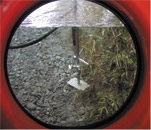DIY flood helps urban stream restoration

Ever wanted to create your own flood? NIWA scientists in Christchurch have done just that.
In some parts of the country, councils are replanting the banks of degraded streams, and even re-establishing submerged aquatic plants. Native vegetation should benefit urban streams by stabilising banks, filtering contaminants, and providing shade, food, and habitat. But these plants can also reduce a stream’s ability to carry floodwaters.
The Christchurch City Council wanted to find out the effects of different instream and riparian vegetation management strategies on flood levels.
First, we studied five streams and developed a formula which predicts how plants in a stream would increase the ‘hydraulic resistance’ (or how much the water is slowed down).
And the flooding? We pumped water from a fire hydrant into a carefully selected and prepared Christchurch stream, testing out the effects of two plants frequently used in restoration projects. Thousands of the plants had to be put in the stream and then removed again within hours. Resistance due to stiff, branched kanuka was higher than from sedge (a flexible tussock), and increased with the density of both plants.
The verdict from Council staff: ‘NIWA gave valuable practical recommendations. The knowledge and relationships will help in better designing stream naturalisation and restoration, weed management practices, and improving predictions of flood levels. This project is an example of a collaborative approach towards achieving the best results, thus providing a wide public benefit.’
